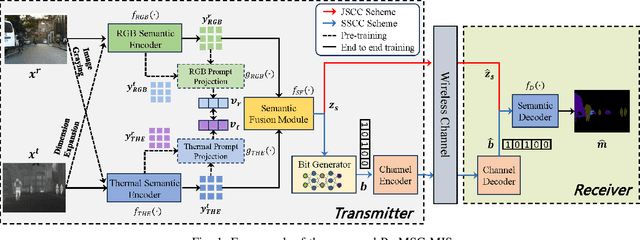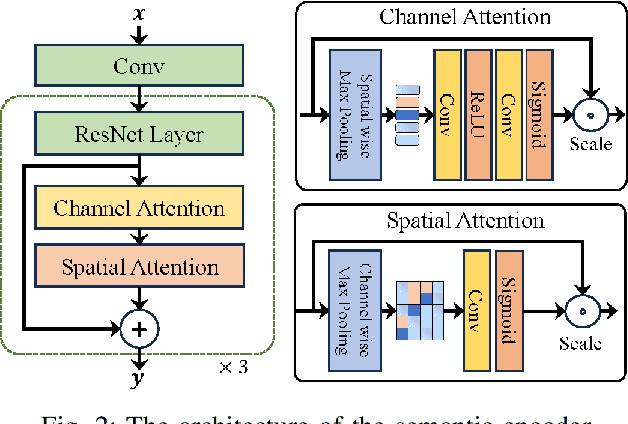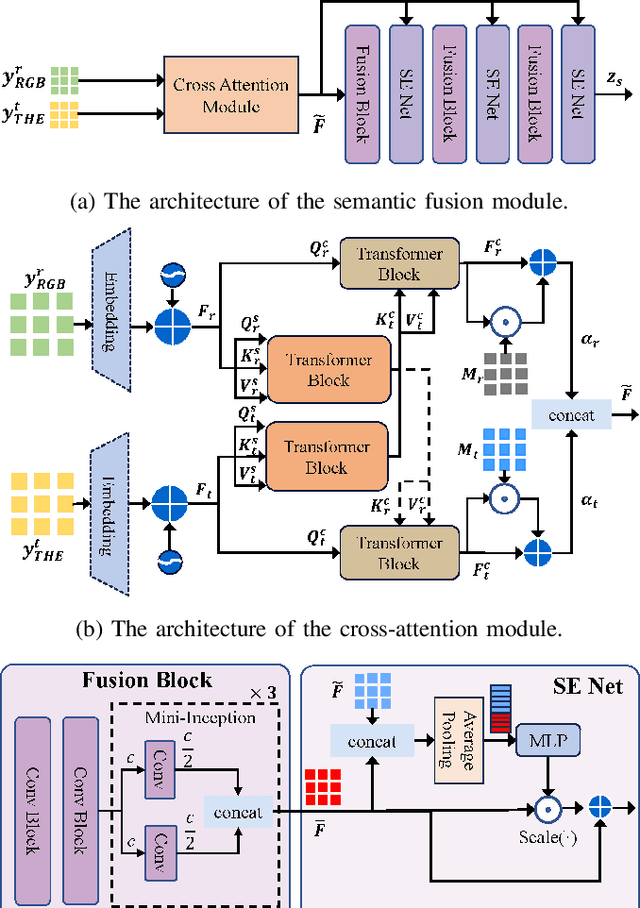Meixia Tao
BitSemCom: A Bit-Level Semantic Communication Framework with Learnable Probabilistic Mapping
Oct 30, 2025Abstract:Most existing semantic communication systems employ analog modulation, which is incompatible with modern digital communication systems. Although several digital transmission approaches have been proposed to address this issue, an end-to-end bit-level method that is compatible with arbitrary modulation formats, robust to channel noise, and free from quantization errors remains lacking. To this end, we propose BitSemCom, a novel bit-level semantic communication framework that realizes true joint source-channel coding (JSCC) at the bit level. Specifically, we introduce a modular learnable bit mapper that establishes a probabilistic mapping between continuous semantic features and discrete bits, utilizing the Gumbel-Softmax trick to enable differentiable bit generation. Simulation results on image transmission demonstrate that BitSemCom achieves both competitive performance and superior robustness compared to traditional separate source-channel coding (SSCC) schemes, and outperforms deep learning based JSCC with uniform 1-bit quantization, validating the effectiveness of the learnable bit mapper. Despite these improvements, the bit mapper adds only 0.42% parameters and 0.09% computational complexity, making BitSemCom a lightweight and practical solution for real-world semantic communication.
Spatial Computing Communications for Multi-User Virtual Reality in Distributed Mobile Edge Computing Network
Oct 16, 2025Abstract:Immersive virtual reality (VR) applications impose stringent requirements on latency, energy efficiency, and computational resources, particularly in multi-user interactive scenarios. To address these challenges, we introduce the concept of spatial computing communications (SCC), a framework designed to meet the latency and energy demands of multi-user VR over distributed mobile edge computing (MEC) networks. SCC jointly represents the physical space, defined by users and base stations, and the virtual space, representing shared immersive environments, using a probabilistic model of user dynamics and resource requirements. The resource deployment task is then formulated as a multi-objective combinatorial optimization (MOCO) problem that simultaneously minimizes system latency and energy consumption across distributed MEC resources. To solve this problem, we propose MO-CMPO, a multi-objective consistency model with policy optimization that integrates supervised learning and reinforcement learning (RL) fine-tuning guided by preference weights. Leveraging a sparse graph neural network (GNN), MO-CMPO efficiently generates Pareto-optimal solutions. Simulations with real-world New Radio base station datasets demonstrate that MO-CMPO achieves superior hypervolume performance and significantly lower inference latency than baseline methods. Furthermore, the analysis reveals practical deployment patterns: latency-oriented solutions favor local MEC execution to reduce transmission delay, while energy-oriented solutions minimize redundant placements to save energy.
Maritime Communication in Evaporation Duct Environment with Ship Trajectory Optimization
Oct 08, 2025Abstract:In maritime wireless networks, the evaporation duct effect has been known as a preferable condition for long-range transmissions. However, how to effectively utilize the duct effect for efficient communication design is still open for investigation. In this paper, we consider a typical scenario of ship-to-shore data transmission, where a ship collects data from multiple oceanographic buoys, sails from one to another, and transmits the collected data back to a terrestrial base station during its voyage. A novel framework, which exploits priori information of the channel gain map in the presence of evaporation duct, is proposed to minimize the data transmission time and the sailing time by optimizing the ship's trajectory. To this end, a multi-objective optimization problem is formulated and is further solved by a dynamic population PSO-integrated NSGA-II algorithm. Through simulations, it is demonstrated that, compared to the benchmark scheme which ignores useful information of the evaporation duct, the proposed scheme can effectively reduce both the data transmission time and the sailing time.
Spectrum Prediction in the Fractional Fourier Domain with Adaptive Filtering
Aug 25, 2025Abstract:Accurate spectrum prediction is crucial for dynamic spectrum access (DSA) and resource allocation. However, due to the unique characteristics of spectrum data, existing methods based on the time or frequency domain often struggle to separate predictable patterns from noise. To address this, we propose the Spectral Fractional Filtering and Prediction (SFFP) framework. SFFP first employs an adaptive fractional Fourier transform (FrFT) module to transform spectrum data into a suitable fractional Fourier domain, enhancing the separability of predictable trends from noise. Subsequently, an adaptive Filter module selectively suppresses noise while preserving critical predictive features within this domain. Finally, a prediction module, leveraging a complex-valued neural network, learns and forecasts these filtered trend components. Experiments on real-world spectrum data show that the SFFP outperforms leading spectrum and general forecasting methods.
Prompt-based Multimodal Semantic Communication for Multi-spectral Image Segmentation
Aug 25, 2025



Abstract:Multimodal semantic communication has gained widespread attention due to its ability to enhance downstream task performance. A key challenge in such systems is the effective fusion of features from different modalities, which requires the extraction of rich and diverse semantic representations from each modality. To this end, we propose ProMSC-MIS, a Prompt-based Multimodal Semantic Communication system for Multi-spectral Image Segmentation. Specifically, we propose a pre-training algorithm where features from one modality serve as prompts for another, guiding unimodal semantic encoders to learn diverse and complementary semantic representations. We further introduce a semantic fusion module that combines cross-attention mechanisms and squeeze-and-excitation (SE) networks to effectively fuse cross-modal features. Simulation results show that ProMSC-MIS significantly outperforms benchmark methods across various channel-source compression levels, while maintaining low computational complexity and storage overhead. Our scheme has great potential for applications such as autonomous driving and nighttime surveillance.
Directional Measurements and Analysis for FR3 Low-Altitude Channels in a Campus Environment
Jul 16, 2025Abstract:In this paper, we present detailed low-altitude channel measurements at the FR3 band in an outdoor campus environment. Using a time-domain channel sounder system, we conduct two types of measurements: path loss measurements by moving the transmitter (Tx) at one-meter intervals along a 26-point rooftop path, and directional power angular spectrum measurements through antenna scanning at half-power beam width intervals. The path loss analysis across different Rx shows that the close-in model outperforms conventional 3GPP models and height-corrected variants, with path loss exponents close to free space values indicating line-of-sight dominance. The power angular spectrum measurements show that propagation behavior varies significantly with environmental conditions. Closer Rx exhibit stronger sensitivity to ground reflections during downward Tx tilting, while obstructed links display uniform angular characteristics due to dominant scattering effects, and corridor environments produce asymmetric power distributions. These results indicate that low-altitude propagation is characterized by complex interactions between Tx height and ground scattering mechanisms, providing fundamental insights for channel modeling in emerging mid-band communication systems.
Distributed Image Semantic Communication via Nonlinear Transform Coding
Jun 09, 2025Abstract:This paper investigates distributed source-channel coding for correlated image semantic transmission over wireless channels. In this setup, correlated images at different transmitters are separately encoded and transmitted through dedicated channels for joint recovery at the receiver. We propose a general approach for distributed image semantic communication that applies to both separate source and channel coding (SSCC) and joint source-channel coding (JSCC). Unlike existing learning-based approaches that implicitly learn source correlation in a purely data-driven manner, our method leverages nonlinear transform coding (NTC) to explicitly model source correlation from both probabilistic and geometric perspectives. A joint entropy model approximates the joint distribution of latent representations to guide adaptive rate allocation, while a transformation module aligns latent features for maximal correlation learning at the decoder. We implement this framework as D-NTSC for SSCC and D-NTSCC for JSCC, both built on Swin Transformers for effective feature extraction and correlation exploitation. Variational inference is employed to derive principled loss functions that jointly optimize encoding, decoding, and joint entropy modeling. Extensive experiments on real-world multi-view datasets demonstrate that D-NTSC and D-NTSCC outperform existing distributed SSCC and distributed JSCC baselines, respectively, achieving state-of-the-art performance in both pixel-level and perceptual quality metrics.
Diffusion Models-Aided Uplink Channel Estimation for RIS-Assisted Systems
Jun 09, 2025Abstract:This letter proposes a channel estimation method for reconfigurable intelligent surface (RIS)-assisted systems through a novel diffusion model (DM) framework. We reformulate the channel estimation problem as a denoising process, which aligns with the reverse process of the DM. To overcome the inherent randomness in the reverse process of conventional DM approaches, we adopt a deterministic sampling strategy with a step alignment mechanism that ensures the accuracy of channel estimation while adapting to different signal-to-noise ratio (SNR). Furthermore, to reduce the number of parameters of the U-Net, we meticulously design a lightweight network that achieves comparable performance, thereby enhancing the practicality of our proposed method. Extensive simulations demonstrate superior performance over a wide range of SNRs compared to baselines. For instance, the proposed method achieves performance improvements of up to 13.5 dB in normalized mean square error (NMSE) at SNR = 0 dB. Notably, the proposed lightweight network exhibits almost no performance loss compared to the original U-Net, while requiring only 6.59\% of its parameters.
Passive Detection in Multi-Static ISAC Systems: Performance Analysis and Joint Beamforming Optimization
Jun 08, 2025Abstract:This paper investigates the passive detection problem in multi-static integrated sensing and communication (ISAC) systems, where multiple sensing receivers (SRs) jointly detect a target using random unknown communication signals transmitted by a collaborative base station. Unlike traditional active detection, the considered passive detection does not require complete prior knowledge of the transmitted communication signals at each SR. First, we derive a generalized likelihood ratio test detector and conduct an asymptotic analysis of the detection statistic under the large-sample regime. We examine how the signal-to-noise ratios (SNRs) of the target paths and direct paths influence the detection performance. Then, we propose two joint transmit beamforming designs based on the analyses. In the first design, the asymptotic detection probability is maximized while satisfying the signal-to-interference-plus-noise ratio requirement for each communication user under the total transmit power constraint. Given the non-convex nature of the problem, we develop an alternating optimization algorithm based on the quadratic transform and semi-definite relaxation. The second design adopts a heuristic approach that aims to maximize the target energy, subject to a minimum SNR threshold on the direct path, and offers lower computational complexity. Numerical results validate the asymptotic analysis and demonstrate the superiority of the proposed beamforming designs in balancing passive detection performance and communication quality. This work highlights the promise of target detection using unknown communication data signals in multi-static ISAC systems.
Channel Knowledge Maps for 6G Wireless Networks: Construction, Applications, and Future Challenges
May 30, 2025Abstract:The advent of 6G wireless networks promises unprecedented connectivity, supporting ultra-high data rates, low latency, and massive device connectivity. However, these ambitious goals introduce significant challenges, particularly in channel estimation due to complex and dynamic propagation environments. This paper explores the concept of channel knowledge maps (CKMs) as a solution to these challenges. CKMs enable environment-aware communications by providing location-specific channel information, reducing reliance on real-time pilot measurements. We categorize CKM construction techniques into measurement-based, model-based, and hybrid methods, and examine their key applications in integrated sensing and communication systems, beamforming, trajectory optimization of unmanned aerial vehicles, base station placement, and resource allocation. Furthermore, we discuss open challenges and propose future research directions to enhance the robustness, accuracy, and scalability of CKM-based systems in the evolving 6G landscape.
 Add to Chrome
Add to Chrome Add to Firefox
Add to Firefox Add to Edge
Add to Edge